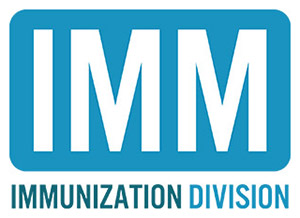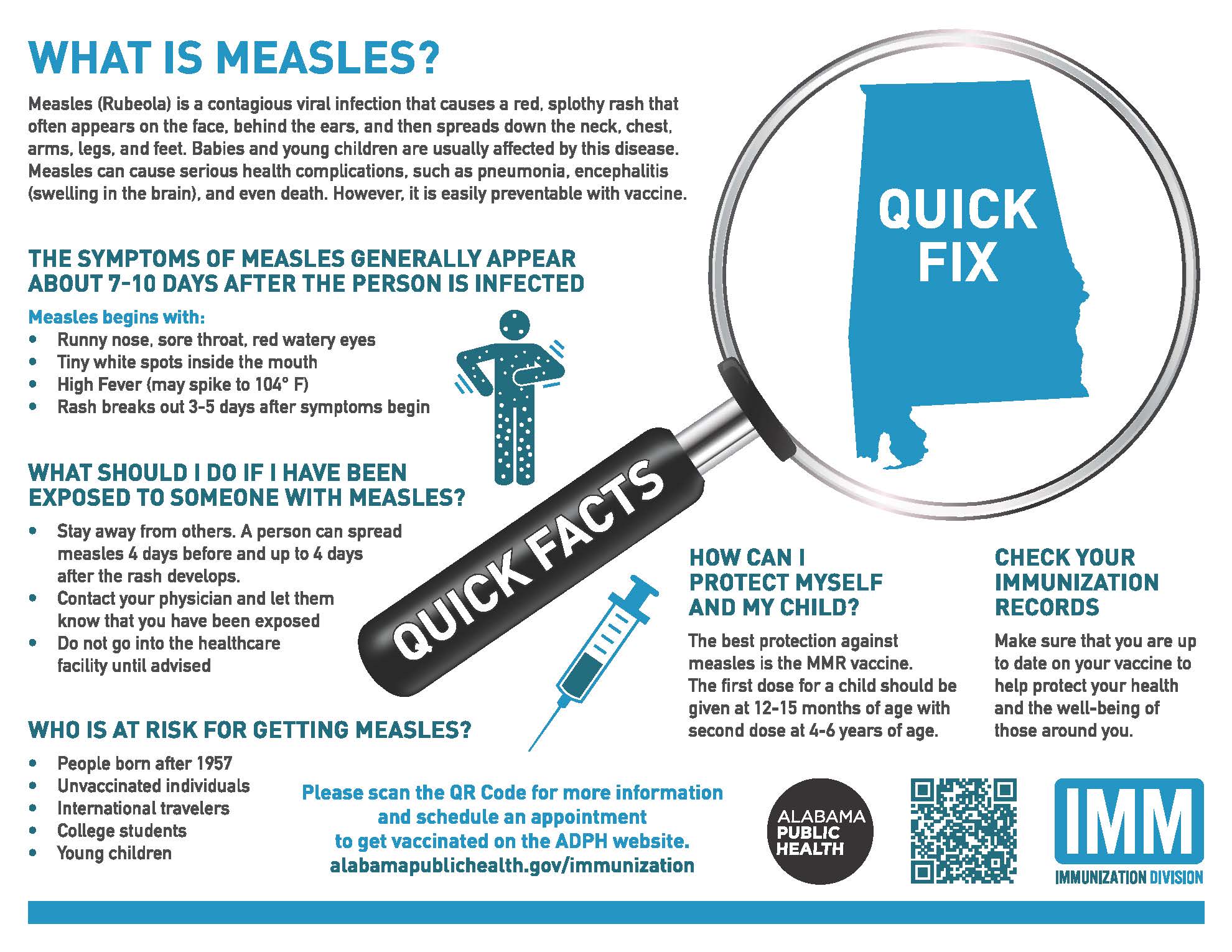
- Immunization Home
- ImmPRINT
- Immunization Quality Improvement for Providers (IQIP)
- Vaccines for Children Program
- Investigations and Cases
- Measles Disease
- Outreach and Education
- Vaccine Information
- School Entry Survey
- Immunization Resources
- Alabama Adolescent And Adult Vaccination Task Force
- Data Requests
- Contact Us
Measles Disease
ADPH announces first case of measles in Alabama since 2002; MMR vaccination is encouraged (08/25/25 News Release)
Schedule an appointment to get vaccinated.
 Healthcare Provider Resources
Healthcare Provider Resources
- To report Measles, you must complete the Measles Testing and Consultation Form.
- Interim Infection Prevention and Control Recommendations for Measles in Healthcare Settings
- *CDC Be Ready Toolkit - Provider Resources - updated guidance to ensure adults are up-to-date on the MMR vaccine
- MMR Travel and Outbreak Recommendations Letter
- Healthcare Providers: Stay Alert for Measles Cases
- Alabama Pediatrician Podcast: Before There Were Vaccines
- Provider Poster for Measles Control Measures
- Guidance for Measles Specimen Collection, Shipping and Testing
- Requisition for Containers, Kits, and Forms
- Flow Chart: Evaluating a Patient Presenting With a Rash When There is No Local Measles Transmission
Measles Resources
- CDC Measles
- CDC's Be Ready for Measles Toolkit
- To see what the measles rash really looks like, see CDC's Collection of Measles Photos.
- ADPH Measles Flyer | En Español
- ADPH Measles Fact Sheet | En Español
- Additional ADPH Resources: Infographic Poster, Stop Poster 1, and Stop Poster 2
- En Español: Infographic Poster, Stop Poster 1, Stop Poster 2
Measles in 2024: An Urgent Call to Action
With measles cases rising in the U.S. and worldwide, concern is growing among parents and health professionals. In a podcast, Measles in 2024: An Urgent Call to Action, Dr. David Kimberlin from UAB joins the Alabama Regional Center for Infection Prevention and Control to discuss what’s behind the outbreak, how it affects children, and how to help protect our communities.
Videos
Frequently Asked Questions
- Measles is a serious viral respiratory illness that lives in the nose and throat mucus of infected people.
- A single case of measles will infect up to 95% of unvaccinated people who are exposed and could result in as many as 18 additional cases.
- Up to 20-30% of infected people have complications from the disease, especially children less than 5 years of age or adults over 20 years of age.
- The best prevention against measles is receiving the measles, mumps, rubella (MMR) vaccine.
For more information, download our Informational Flyer on Measles.
- Symptoms appear 7 to 14 days after a person is infected
- Common early symptoms include:
- High fever, up to 105°F
- Cough
- Runny nose
- Red or watery eyes
- Two to three days after symptoms begin, you may have:
- Tiny white spots appear inside of the mouth.
- Three to five days after symptoms begin, you could also have:
- A rash of flat red spots on the face, which could also spread to the neck, chest, arms, legs, and feet.
- Small raised bumps appear on the flat red spots.
- Common complications may include ear infections, hearing loss, and diarrhea.
- Severe complications may include pneumonia, swelling of the brain, and death.
- Measles is very contagious and may live up to 2 hours in the air or on surfaces after an infected person coughs or sneezes.
- People can spread measles to others four days before and four days after the rash appears.
- Measles is spread from person to person through
- Coughing and sneezing
- Touching items and surfaces the infected person has coughed or sneezed on.
- The first dose of the MMR vaccine is recommended for children aged 12 through 15 months, and the second dose for children aged 4 through 6. Two doses are over 97% effective in preventing measles.
- If a person has not been vaccinated and is exposed to measles, one dose of MMR within 72 hours of exposure reduces the chance of getting measles.
- Infants and children, students at post-high school institutions, and healthcare staff should get 2 doses of MMR.
- Adults born after 1956 should get at least one dose of MMR.
- Women of childbearing age should get at least one dose of MMR before getting pregnant if they do not have records of complete vaccination.
- International travelers should be up-to-date on MMR before traveling.
People with a contraindication for MMR or MMRV vaccine should not receive the vaccine, including:
- Anyone who has had a severe allergic reaction (e.g., anaphylaxis) after a previous dose of MMR or to a vaccine component
- Anyone who has a known severe immunodeficiency (e.g., from hematologic and solid tumors, receipt of chemotherapy, congenital immunodeficiency, or long-term immunosuppressive therapy or patients with human immunodeficiency virus [HIV] infection who are severely immunocompromised)
- Is pregnant
For more information, visit the CDC's Contraindications and Precautions for MMR Vaccination.
- Getting the MMR vaccine is much safer than getting measles disease. The risk of the MMR vaccine causing serious harm or death is extremely small.
- MMR does not cause autism. Organizations like Autism Speaks, urge parents/guardians to vaccinate all children.
- While rare, a vaccine, like any medicine, is capable of causing side effects or allergic reactions.
- The most common side effects are mild and usually occur within two weeks of the vaccine. These include but are not limited to:
- Soreness or redness or rash where the shot was given
- Fever
- Swelling of glands in the neck or cheek
- Moderate to severe problems include but are not limited to:
- Seizures caused by fever, temporary pain or stiffness in the joints, temporary low platelet count, severe allergic reactions, and deafness.
- Contact your doctor or pharmacist.
- Visit the Centers for Disease Control and Prevention.
You’re well-protected (97% effective) and don’t need a booster if you:
- Have two doses of MMR or MMRV
- Were born before 1957 (most people were naturally exposed to measles and are assumed immune)
Exception: If you received the inactivated measles vaccine between 1963-1967, you may need a booster. Check with your healthcare provider if unsure.
Measles antibodies last a long time. Studies show that around 91% of those who are vaccinated still have protective antibodies after 17 years. Modeling studies estimate that a single dose of MMR provides protection for about 25 years and that two doses extend immunity further. Scientists estimate measles antibodies have a half-life of over 3,000 years, supported by T and B cells.
Our recommendations may evolve, but current data remains strong. Changes could occur due to reduced measles exposure and the absence of periodic immune boosts from asymptomatic infections.
The MMR vaccine works incredibly well—you’re 35 times less likely to get measles than someone with no immunity.
However, no vaccine is perfect. A breakthrough case is rare but possible (3 out of 100 fully vaccinated people will get infected), but the illness is typically mild.
We don’t know why there are breakthrough cases, but there are two possibilities: waning immunity, or the vaccine didn’t work in the first place for whatever reason. Roughly 7% of people do not get protection after the first dose, but of those, 95% will be fully protected after a second dose. Only a small percentage of people don’t respond to both doses.
Transmission after vaccination, especially if you’re asymptomatic, is rare.
-
A small study found no viral shedding among asymptomatic or mildly ill patients. However, this is a very old study, and we need to replicate its findings with more sensitive lab equipment.
-
While several studies show spread among vaccinated people, especially after intense or prolonged exposure, it’s limited.
A 2011 New York outbreak was the first documented case of a fully vaccinated person spreading measles. Out of 88 close contacts, only four got infected—and none of their contacts got sick. We would have expected about a 90% infection rate if this had been an unvaccinated case.
- Maternal antibodies waning (see "Is a baby protected if their mom was fully vaccinated?" below)
- Maturity of the immune system
- The most common age of infection
The second MMR dose can be given 28 days after the first—unless it’s the MMRV vaccine, which requires a 3-month gap.
This flexibility is especially useful in outbreak areas. Healthcare providers may recommend a second dose earlier for children aged 1 to 4 who live in or are visiting outbreak areas.
Longer intervals between doses generally strengthen immunity, so some worry that shortening the measles vaccine interval could weaken protection. However, data suggest timing isn’t a major factor in long-term immunity as long as the first dose doesn’t interfere with the second (requiring at least four weeks between them).
The second dose, typically given at ages 4-6, ensures protection before school, where measles spreads easily. It’s not technically a booster, but it helps cover the 7% of people who don’t respond to the first dose. Without it, gaps in immunity can fuel outbreaks.
The vast majority of moms transfer antibodies to their fetuses. Once born, antibodies wane quickly and are almost all gone at 6-12 months of age.
Breastfeeding may provide some protection but is not a substitute for vaccination. Breastmilk antibodies may play a role in protecting against measles, but there is a lack of robust supporting evidence.
Anyone trying to conceive should have MMR titers checked, and if levels are low, MMR should be administered 28 or more days before conception.
Different viruses mutate and infect differently.
- Measles mutates far less than flu. The measles virus from the 1960s is virtually the same today, unlike the flu, which changes every couple of months.
- Measles replicates slowly and deep in the body, giving the immune system time to act. Flu replicates quickly in the nasal passages, making it harder for the body to stop transmission.
Getting a booster has very few risks. However, unnecessary boosters could contribute to a vaccine shortage. 12 million doses are available in the country each year. Priority must be given to children since they need at least two for initial protection.
Infection-induced immunity may last slightly longer, but at a high cost—measles can lead to severe complications, including pneumonia, encephalitis, and death.
The MMR vaccine offers strong, long-lasting protection. It’s a live virus vaccine, so it’s a tiny, controlled version of the infection for all intents and purposes—but with far fewer risks.
Titers measure antibodies in your blood but don’t account for T cell and B cell immunity, which also protect you.
T cell and B cell memory are particularly important because once measles enters your body, it doesn’t replicate that fast. It is slow enough that if you get infected, they will start pumping out antibodies to prevent you from getting sick. This means that a negative result on titers does not necessarily mean you are not protected.
The main reason to get titers checked would be as a matter of insurance coverage for a booster-—some plans won’t cover the cost unless titers to one of the MMR viruses come back negative.
Checking titers could also be useful for pregnant women. Refer to the question above: "Is a baby protected if their mom was fully vaccinated?"
Page last updated: October 27, 2025




